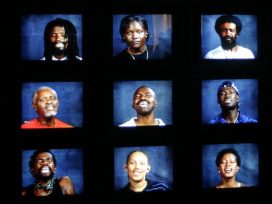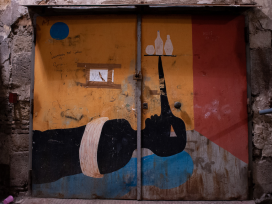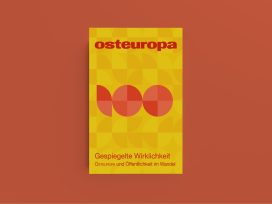The comparative poetry journal Semicerchio is a platform where readers can observe different movements and newly forming sensibilities. This is chiefly because the journal constantly and, I would say, systematically monitors poetic production in various languages and countries – from Germany to China, from Albania to Brazil, from Australia to – obviously – Italy. This broad vision is similar to using the remote control and “zapping” the TV screen, dividing it into several windows: it prevents the viewer being too drawn into any individual movie and allows a more exact and comprehensive view of what is on offer. The view permits a horizontal exploration and can suggest a kind of textual evaluation that approaches every critical problem through a relative and comparative dimension. Perhaps, most importantly, it makes it possible to observe the object “Italian poetry” from outside. This can lead to a muffling of the intensity and urgency with which one participates in discussions, or shares a critical position. It can also guarantee a more informed knowledge base, if not a greater “objectivity”, which can often be an empty term. This greater base is an indispensable factor in the project of perceiving and thinking of poetry in a society that defines itself as “globalized”.
The 2006 issue of the journal tackles an apparently old problem that has also been raised in an essay much discussed in Italy: La poesia moderna by Guido Mazzoni, published 2005 by il Mulino: it is the problem of the “social mandate” of the poet, the gesellschaftlicher Auftrag mentioned in 1874 with regard to Baudelaire. In Italy this issue has been approached several times over previous decades, especially after the famous essay by Fortini. There was confusion between this question and the related but also completely different problem of the social role of the poet and of the relationship between poetry and reality, or worse yet, of poetry and civil poetry.
In the last two chapters of his work, deeply inspired by Benjamin and especially by the artistic sociology of Bourdieu, Mazzoni speaks of the birth of a new humanistic canon. According to Mazzoni, it would “perhaps be the most important social transformation in western culture of the past three centuries. This is similar in certain aspects to the metamorphosis of literary genres in the eighteenth century, which lead to the creation of a new type of intellectual, causing the development of journalism, the novel, bourgeois drama and modern poetry.” Mazzoni sees signs of this transformation in the avantpop origins of several of the best writers, in the mid-cult tastes that progressively occupy the canon of popular art, and in the opening of university programmes to show-business and TV culture. A symptom of this transformation, according to the author, is the “grave crisis of legitimacy” that has hit some sectors of high humanistic culture: from art installations that replicate senseless absurdities a hundred years after the twentieth-century avant-garde movements, to poetry.
Poetry lives – often quite well – in restricted auto-referential circles because it has lost the necessary symbolic power needed to address shared values. It has ceded this power to other media such as pop music, which have, according to the author, a greater capacity to express what Mazzoni calls “narrations of states of exception” to occupy the space that epic literature once occupied. These media receive a devolution of social representation that is much broader and wider than that of poetry. This situation is instrumental in influencing the behaviour of poetry groups, of the anthropology of poetry and also to a great extent the stylistic phenomena that one finds in contemporary poetic texts: the fragmentation of language, the manneristic meta-writing, the theatricality, the forceful irony, the minimalist narcissism and the obsession with experimentation.
Our first impression is that Mazzoni’s irreverent analysis, although containing acute observations, has reversed the direction of factors: the loss of mandate is not the sign but the cause of this dislocation, and is not caused by linguistic choices or behaviours of certain groups, as described in the book. The loss is a consequence of socio-cultural changes that are independent of the wills of individuals or collective literary lobbies.
Our second impression is that one is dealing with a very recent phenomenon, at least in Italy. In the preface to an anthology of contemporary Italian poetry in 1996, Stefano Giovanardi acknowledges the existence of the problem right from the second page. However he pre-dates the problem, perhaps following Benjamin, speaking of a “brusque cessation of the social mandate of the poet” in reference to the fin de siÈcle change between symbolism and the avant-garde, between Mallarm and Apollinaire. According to Giovanardi, even from Pascoli’s time, the poet is no longer “the intellectual or the collective voice”, but only possesses a mere ambition for it. And yet we all know how important a personality such as D’Annunzio was for Italian culture, whose oracle-like influence inspired televised readings by Ungaretti even in the 1970s. Not to mention the charisma exuded by Pasolini’s every word: until his death and even after, they remained not only the objects of discussion but also an element of identification and of representation of opinions and of common language. At least in Florence, the personality of Mario Luzi represented the only high point of unity until recently. The phenomenon is therefore new, as Pier Vincenzo Mengaldo observed in an interview a while ago. It has manifested itself only in the past 20 to 25 years, so we cannot affront the question by backdating it, or by using the convenient formula of auto-referentiality and detachment from social dialogue, from so-called “reality”.
We have planned, therefore, that Semicerchio proposes a discussion about the clinical observations of Mazzoni between important poets from all parts of the world: from Dieter Grf to Jorie Graham, from Gozo Yoshimashu to Yves Bonnefoy, from Antonis Fostieris to Jos Munarriz and Jaroslaw Mikolajewski and others; a truly international network for which I have to thank our editors.
At the moment of writing the picture is yet to be completed, but the numerous contributions that have arrived delineate a tough and compact front of resistance. They represent a uniform and almost “corporative” reaction to the warnings given by Mazzoni. I cannot list all the arguments here, but almost everywhere one can see an absolute trust in the continuity of poetic expression, the conviction of the long lifespan of the genre and its prestige, the certainty that its specific means of communication acts on a social level even in instances where the poetry might not seem to be connected to any external reference. In some of the cases, the replies even express a disgusted refusal of formulae such as “social legitimization” which, although coming from the Frankfurt School, have been oddly connected by some poets even to Stalin and socialist realism, while the French poets did not have difficulties in acknowledging these ideas as the Bourdieu approach.
The negation of a crisis of poetry is unanimous, and is based on both the enthusiasm with which many environments in all parts of the world enjoy and encourage poetry – editors, reviews, cultural centres, anthologies, prizes, schools, etc. – as well as on the sensation of aesthetic vitality of production, especially in the postcolonial countries, where many poets with clear stylistic personalities have continued to emerge. The answers from the poets go as far as to negate the existence itself of a social question, noting that poetry has never had many readers, and the points made by the respondents are almost as many as the respondents themselves: some bring back the ancient argument that poetry is, in any case, a social phenomenon, in the sense that it is in dialogue and it interacts with society independent from the degree of communicability of its language. Still others negate that poetry’s relationship with society should be posed as a problem, while others point to the testimony of the great durability of the literary canon as proof of the independence of the poet’s text from social controls.
All of the poets refute the function of the poem as song, with the exception of the New York-based Anglo-Indian poet Meena Alexander, who says, “There is a truth here, that songs have taken over the space that traditionally was the reserve of poetry.” But she contradicts this lucid observation when she declares that she restores this dimension in her poetry by allowing herself to be influenced by the traditional songs of her land of origin: she thus shows that it has not been understood that the problem is not one of expressive or rhythmic genre but of social credit.
Not one poet, it seems to me, has taken note that the “social mandate”, in English and Italian more than in the original German, is a concept that points to the social representativeness of the poet, and not to his or her social role. The problem is not how much the poet is (or feels that his or her writing is) in agreement or in dialogue with society or with historic reality. The question is about the degree to which society recognizes the figure of the poet as a source of expression of collective sentiments and languages, and of identification of symbolic values.
Mazzoni, in his study, begins with a test that is analogous to that recounted in the 2006 issue of the journal Atelier by Alberto Bertoni, in which it was found that in the Italian department of one of the big universities, only two or three students of about one hundred were able to cite the names of living Italian poets. The phenomenon seems even more dramatic when young people are asked to express a concept or an emotion in a stylistically efficient and citable formula, to make use of a verse by a contemporary poet. The answer is unanimous: the formation of a pool of memorable expressions, the phraseological and proverbial vocabulary of a community, is no longer the function of literature, and especially of poetry. They are found to repeat either the clichs of the cultural patrimony, such as Petrarch or the Divine Comedy – or else resort to songs (or worse, to advertising slogans). In the same way, the construction of grand identifiable narrations has for some decades, at least since the Vietnam War, been the role given to cinema.
All this eluded the poets that we questioned, probably also because of some lack of clarity in our questions. Or perhaps all these phenomena were not considered to be a sufficient reason to justify the definition of a crisis of poetic prestige. And yet, in order to reflect upon the possibility of a canon, a central, and I would say preliminary point of consideration would be the legitimacy of a canon in itself.
Mazzoni is certainly very clear at least in one aspect of his deconstruction – with a coolness comparable to the pre-Bloom Anglo-American criticism of Kermode. Hundreds and thousands of students must read Leopardi’s L’Infinito, a text of 15 verses that describes the short experience of an individual who meditates behind a hedge. The reason for this, if one has to avoid consolatory assessments, is that the hegemonic circles of our society decided to attribute to this text the function of a symbolic representation. It is an almost fetishist representation of a value that is considered fit to enter into the formative patrimony of an Italian citizen, and hence the repertory of that which is unquestionably seen to produce valuable meaning: the text has been endowed, in other words, with authority. This poetic value does not depend only upon the vitality or the quality of production of a single person or a group, but upon broader cultural or even social dynamics.
The argument that there are always more and more poets who write better and better works, and that there are always more editors who appreciate this output, seems to reassure so many of the world’s poets. But these factors do not have no decisive effect, since these are not the aspects that will decide the role of poetry in tomorrow’s culture, in the same way as, let’s say, a bigger success of bonsai clubs will not be sufficient to influence the academic canons leading them to substitute an hour of bonsai for an hour of mathematics or computer-literacy.
The absence of poetry from the cultural canons
The theme of the absence of a canon can be translated into the theme of the future absence of contemporary poetry from the canons of cultural works that have influenced our times since approximately 1970. As Mazzoni so bluntly puts it, cynically playing with a paradox, one can hardly compare the cultural impact exercised in our times by two artists of the same age, Seamus Heaney, born in 1939, and Paul McCartney, born in 1940.
The second aspect of the problem is the absence of a universally accepted canon of twentieth century Italian poetry, especially concerning the second half of the twentieth century. Semicerchio has not stated a position on this problem: some of its editors and collaborators independently participated in 2005 in a kind of philological repertory of contemporary poetic activity, entitled Parola plurale (“Plural word”). Coordinated by Andrea Cortellessa, the project was never discussed by the editors before it was released in print. The comments by Pierluigi Pellini, which were published in Semicerchio, kindly but also severely diagnosed both the ambitions and the limits of the undertaking.
The questions of the canon has in general been at the centre of attention in Italy more than in some other places. This because of the publication of The Western Canon by Bloom, which has led to a series of theoretical debates and publications of a high academic quality over the last ten years, as well the necessity to make the values of groups that contend with each other in Italy visible, thus leading to a proliferation of varying anthologies. For these reasons, instead of maturing, the debate has become paralysed. The silence was created not by absence, but by the excess of canons and maps and the absence of any kind of authority. Perhaps, as Belardinelli wrote in 1999, “just as everything was being relativized, the need for absolutes increased”. Or perhaps, more probably, the easily diffused creativity and the immediate access by aspiring poets to publication led to a need for tools that would somehow regulate the excessive quantities of information.
It is evident that from the point of view of the reader that an anthology does not immediately signify “canon”. However from the point of view of the editor of the anthology, it certainly represents a proposal of values that would hopefully be considered as common values. Beginning from the times of the violent Sanguineti/Mengaldo opposition, there were distinctions created between single and multiple author anthologies, the anthology as manifesto and as museum, philological criteria versus philosophical criteria, company canons versus ideological ones, militant canons versus scholastic ones. We arrived at Stefano Verdino’s coining of the term “polycentric canon”. This was a proposal that was formulated at the 1999 conference by Roberto Deidier, Guido Guglielmi and many others; an essay by Rakefet Sheffy explicated the concept in 1998 in The Concept of Canonicity in the Polysystem Theory, a work evidently inspired by the poly-systemic theory of Even-Zohar.
This is a solution that continues to re-appear, and it seems to be, at first sight, the most ecumenical and elastic, and especially, the least evitable one. Each pressure group or lobby that acts upon an editorial power or holds an academic of journalistic visibility and is referred to as a literary or ideological community, if not a specific or distinct culture, proposes its own divisions that concede space to its recognized masters. It positions the canon in formation to poetics or personalities that respond to the criteria with which the group is most closely identified. Thus the canon continues to carry out the identification functions of communities, but it carries out its function upon more limited communities: a kind of federalist canon. These mobile and juxtaposed canons encounter each other apparently in order to undertake critical dialogue, but they also seek to penetrate the reality of the school, the editorial boards, and the universities in order to impress upon these their legitimate convictions.
The mobility of the Italian canon and migration poetry
The absence of a unique anthology, such as that of Mengaldo, has been around for twenty years, can be the only way to avoid anthologies that exclude women or dialect writers (such as that of Sanguineti)), or the avantgardists (like La parola innamorata did) or the neo-romantics (as Parola plurale does), or authors from minor editorial houses, like the Mondadori anthology, or those that avoid male writers, such as the anthologies of Laura di Nola and Biancamaria Frabotta, or the poets of different ethnicities or any majority or minority that would like to have a valid literary recognition. And yet this apparent opening of the canon continued to base itself upon exclusions, which would not be noticed and perceived until the appearance of another pressure group or lobby. Until 2006, there still lacked an element that would have allowed for a more dynamic situation of the Italian poetic system – that of Italophone poetry. Now this element is present, thanks to the anthology by Mia Lecomte by Le Lettere, which is almost ready to be published in English translation. This anthology was created after a decade of selecting suitable works, starting with the series “Cittadini della poesia”. These poets probably make up a transitory phenomenon, since second-generation immigrants in Italy are completely immersed in the Italian school-system. It would be difficult for them to develop, as in the US or other places, the feeling of belonging to a different canon than the Italian scholastic one. Instead, first generation immigrants have arrived in Italy with a mature external formation, followed by a quick Italian immersion, producing works that are of extraordinary interest to us although the quality is inevitably uneven. One can find a novelty of certain modes of expression, an experimentation of genres unknown to Italian poetry or lost in a dried-up tradition, an introduction of an exotic imaginary in the formulae of Pavese or Montale, a choice of certain models in the Italian tradition that we would perhaps hesitate to recognize, a recovery of compositional figures that are ancient or foreign to the national tradition, but also an authentic urgency to have a dramatic relationship with history that the halls of the literary republics in Europe have lost since the Second World War.
If this neo-Italian poetry was to enter the schools and create new tendencies by interacting with already present eclecticisms, the Italian canon would finally be dealt a big shock – that which Lotman in his essay on the semiosphere defines as an acceleration produced by the entry of an external text into the system – which one retains as a necessary event to exit from the stagnation of good poetry that does not say anything anymore, or of a poetry that has distanced itself from dialogue with society.
For the moment, this is only the last of the possible pressure groups. It is as of yet devoid of political weight and has been perceived until now by the establishment mostly as a phenomenon that merits only charitable attention. This neo-Italian poetry has not yet interacted with the classic national poetic production and is not seen by any one of the other organized groups as an interlocutor, not even in a polemical sense. It has therefore not been seen to influence modes of writing. But this marginal canon is poised to add itself to the sequence of plural canons that flow within the Italian panorama, and has the potential to be a factor that will heal the rigor mortis of the post-Italian, post-twentieth century tradition and thus inaugurate new paths of communication and new dialects that have not existed till now, opening up Italy to a stylistic vision that is more globalized.
A different line of discourse must be made when we speak about the song, one of the subdivisions which Semicerchio decided in 1986 that it would write about, with reviews, metrical analyses, readings and lessons. For the moment, we are dealing with a genre that cannot be superimposed on the genre of poetry. Unless we regard some functions that were once a prerogative of poetry, such as social representation and some formal characteristics, such as the need to incorporate stylistic elements that are derived from a necessity of connecting social representation to texts that will be memorable – quite the element that present-day poetry has renounced. We know that many scholastic anthologies for many years now have included the lyrics of certain songs. People who have edited anthologies know that this phenomenon has not become very common due to the enormous costs of procuring the rights to the use of the lyrics to such a level that the cost for reproducing a single song by Vasco Rossi would cost the same as the reprint of an entire collection of Montale’s verses. A third element that is being absorbed by songs from poetry is the awareness of tradition – so much alive that it is producing in songs many qualities of allusion, rewriting and imitation that are akin to the troubadour tradition.
The role of the popular song: a medieval paradigm
A fourth element, which can be derived from the previous ones, is the influence on the innovation of the commonly used languages and also literature. In this case, the influence of the song is at its peak and that of poetry has almost disappeared. A medievalist, such as I am, would know that this phenomenon already existed in the cultural history of Europe, between the fourth and the ninth centuries, when quantitative classical poetry began to survive only in schools, while in the churches, the monasteries and in the piazzas, a new kind of poetry was forming.
It was a rhythmic and syllabic poetry, used for hymns, for the funerary planctus, for songs of war and love. Slowly these songs, of which we are editing the first textual and musical edition, began to be written and were measured against the rhetorical systems of high literature, and this gave life to modern European poetry. Meanwhile in the schools, quantitative verses, often beautiful ones, continued to be written. But the people sang the other ones, because the linguistic systems lent them higher naturalness. Centuries later Baudelaire wrote in these rhythmic verses and not in quantitative ones.
I cannot say if we are on the threshold of such a major change. It would depend on other factors, such as the degree to which the market is able to influence or determine the choices of the intellectuals and the schools. For the moment it seems that we are at a point of equilibrium. Poetry still has an academic prestige that continues to protect it from rapid substitutions and has ceded the elements of its own expressive system only gradually to the song. We can, however, accept the idea that the song is now acting on the literary system as another of those pressure groups, but from below rather than from above. In some way it modifies the canon and has begun to propose a canon of its own. The song is thus another one of those forces that the system needs in order to exit the expressive universe that has died with the passing of the twentieth century.
So it is this auto-genesis of new canons that gives an impression of an absence of a canon, of the impossibility of a single canon, and consequently of the irrelevance of any canon. This situation is well reflected by theories about the historicity of the canon before and after Bloom, including those created by Kermode or by Hallberg, by Herrnstein Smith and by Lucia Re.
But is it really true that no one canon exists? All the studies – from among the latest one by Cesare Segre in the journal “Allegoria” dedicated to the idea of a canon – underline the exemplarity and the authority inside a given culture as conditions with which one can recognize the canonic status of a work: in a case in which these do not exist, the work would lose its sacred aura which is so much associated with the idea of the canon right from the times of the selection of the biblical texts. This aura also gives weight to the canon’s function as a factor of identity within a community. So anthologies do not form the canon, but the continuity of a widespread perception of an aura does, as does the scholastic tradition that helps create it. A canonic work becomes recognizable, according to Segre, by its inclusion into school textbooks, by the intertextual references it generates in other works, by the creation of more editions and comments; that is to say, when the work becomes a “Text of Culture” to use the terms of Lotman and Uspenskij.
No single lobby is by itself capable of creating a canon that will withstand the passage of time in these terms. In fact, we realize that even Segre’s discourse functions within paradigms that do not exist anymore. Firstly, identification does not exist – as Segre seems to hint – between schools (that is to say, academia) and culture. Secondly, there no longer exists a unitary culture within a complex nation such as ours. And yet, the logic of discourse remains valid: a canon is not an operation of literary marketing, but a process of sedimentation that no institution can control on its own. But the recognition of a unitary authority has diminished. In our societies, the prestige given to power positions in editorial and economic sectors has freed, or one can say popularized, the function of authority which was once an exclusive right of the philological scholars and the university. This new situation has fragmented the authority into a series of multiple and diffuse entities, putting it into the “market” so to speak, and allowing it to be influenced by incessant contractual games. A comprehensive effect of authority is produced partly due to the ability of the community to operate a kind of abstract synthesis of various common points between the various stances recognized by different groups. This is dramatically described by Barbara Herrnstein Smith: “the ‘survival’ or ‘endurance’ of a text […] is the product neither of the objectively […] conspiratorial force of establishment institutions nor of the continuous appreciation of the timeless virtues of a fixed object by succeeding generations of isolated readers, but rather a series of continuous interactions among variably constituted objects, emergent conditions, and mechanisms of cultural selection and transmission. These interactions are, in certain respects, analogous to those by virtue of which biological species evolve and survive […]”.
So the canon exists, it is not absent. And the existence of multiple, partially conflicting canons does not hinder the formation of a single implicit canon which would always allow for some local variations to specific environmental adaptations, and which could conserve a permanent nucleus. This nucleus would be determined by the selection of works that have time and again demonstrated a poly-functionality, a possibility of satisfying the need and the interpretations of different audiences and diverse institutions in different times. A proof of this phenomenon lies in the fact that all the anthologies of the past ten years, notwithstanding their sometimes radical and polemical counter-positions, nevertheless share the names of younger writers that evidently do respond to the prerequisites of poly-functionality and the satisfaction of multiple identity needs, in addition to the masters of the early twentieth century. Find those names, and you will find the canon that the community of poetry lovers, as few as they might be, does recognize quite unanimously as such.
Will this poetic canon, whatever it might contain, still have any weight within the cultural canon of the twenty first century?







